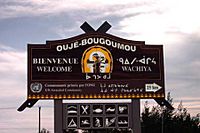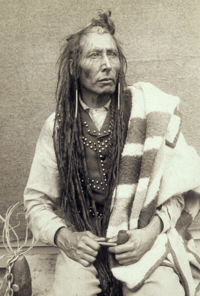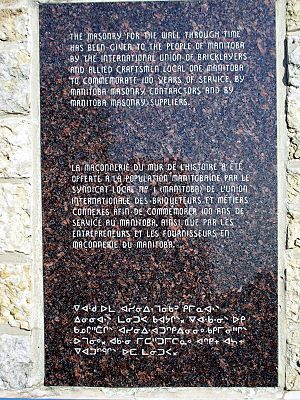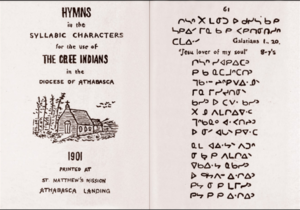Plains Cree language facts for kids
Quick facts for kids Plains Cree |
||||
|---|---|---|---|---|
| ᓀᐦᐃᔭᐍᐏᐣ nēhiyawēwin | ||||

The entrance to Quebec's Oujé-Bougoumou village writes "Welcome" in English, French, and Cree.
|
||||
| Native to | Canada, United States | |||
| Region | Manitoba, Saskatchewan, Alberta, Montana | |||
| Native speakers | 3,200 (2001–2016)e25 | |||
| Language family |
Algic
|
|||
| Official status | ||||
| Official language in | Northwest Territories (Canada), as "Cree" | |||
| Linguasphere | 62-ADA-aa | |||

|
||||
|
||||

Plains Cree, called nēhiyawēwin by its speakers, is a type of Cree language. Cree is the most spoken Indigenous language in Canada. Plains Cree is one of five main Cree dialects.
Even though there are other Cree dialects, Plains Cree is the most widely used. About 34,000 people speak Plains Cree. Most of them live in Saskatchewan and Alberta, but some also live in Manitoba and Montana.
More people are learning and speaking Indigenous languages like Plains Cree. For example, in 2016, over 263,000 people in Canada could speak an Indigenous language. The number of people who speak Plains Cree has also grown over the last 20 years.
Contents
Sounds of Plains Cree
Every language has its own special sounds. Plains Cree has different sounds for its consonants and vowels.
Consonants
Plains Cree has about 10 or 11 consonant sounds. These include sounds like 'w' and 'y', which are like gliding sounds.
Some consonant sounds in Plains Cree can change how they are said. For example, the sounds for 'p', 't', 'k', and 'c' can sometimes sound like 'b', 'd', 'g', or 'j'. This change depends on where the sound is in a word. If it's at the start or end of a word, it usually sounds like 'p', 't', 'k', 'c'. But in the middle of a word, it might sound like 'b', 'd', 'g', 'j'.
Vowels
Plains Cree usually has seven different vowel sounds. These are divided into short and long sounds. Think of it like the 'a' in "cat" (short) versus the 'a' in "car" (long).
The vowel sounds can also change slightly depending on where they are in a word. For example, the long 'ē' sound in southern Plains Cree might sound more like a long 'ī' in northern Plains Cree.

How Sounds Change in Words
Sounds in Plains Cree words can change when different parts of words are put together. This is called phonological processes.
- Adding Sounds: Sometimes, a vowel sound like 'i' is added between other sounds. For example, if you combine two word parts that would make 'atk', the language might add an 'i' to make it 'acik'.
- Dropping Sounds: Sometimes, sounds are dropped. If two 'w' sounds come together, one might be dropped. Also, if a long vowel and a short vowel are next to each other, the short vowel might disappear.
- Changing Sounds: Some sounds can change to make words sound different. For example, the 't' sound can change to a 'c' sound. This often happens when making words sound smaller or cuter, like changing "my horse" (nitēm) to "my little horse" (nicēmisis).
- Shortening Words: In everyday talk, people often shorten words. For example, the greeting tānisi (hello) is often said as tānsi.
Word Stress
In Plains Cree, the stress (which part of the word you say louder) depends on how many syllables a word has.
- For words with two syllables, the stress is on the last syllable. For example, in iskwēw (woman), the stress is on the kwēw part.
- For words with three or more syllables, the stress is usually on the third syllable from the end. Other syllables might also have a lighter stress.
How Words are Built
Plains Cree is a polysynthetic language. This means that words are often built by adding many small parts (like prefixes and suffixes) to a main word. It's like building a long train with many cars!
Nouns
Nouns in Plains Cree are quite simple. They can have prefixes (parts added to the beginning) to show who owns something. For example, ni- can mean "my".
Nouns also use suffixes (parts added to the end) to show different things:
- To make a word sound smaller or cuter (like "little dog").
- To show if there is more than one of something (plural).
- To show location (like "on," "in," or "at"). For example, adding -ihk to niskāt (my leg) makes niskātihk (on my leg).
Verbs
Verbs in Plains Cree are very complex because they carry a lot of information. They can tell you who is doing the action, who the action is being done to, and even when it happened.
- Repeating Parts: Sometimes, parts of verbs are repeated. This can show that an action is happening over and over, or that it's very intense. For example, if the root word means "along," repeating a part might make it mean "about."
Sentence Structure
Word Order
In Plains Cree, sentences often follow a Subject-Verb-Object (SVO) order, like "The children killed some ducks." However, other orders are also possible.
Often, the subject (who is doing the action) or the object (who the action is done to) can be left out of a sentence. This is because the verb itself gives a lot of information. So, "they killed them" could be just one word in Plains Cree.
Who is Doing What?
Plains Cree has a special way to show who is doing an action to whom, especially when talking about third persons (like "he," "she," "it," "they"). This is called direction and obviation.
Imagine you have a man and a dog. If you say "the man scares the dog," the verb will have a special ending that shows the man is the main focus (the proximate third person) and the dog is the less important one (the obviative third person). If you want to say "the dog scares the man," the verb's ending will change to show the dog is now the main focus. This helps avoid confusion about who is doing what.
Location Words
Plains Cree doesn't use words like "on," "in," or "at" in the same way English does. Instead, it uses a special suffix, usually -ihk, added to the end of a noun to show location.
For example, skāt means "leg." If you add -ihk, it becomes skātihk, meaning "on the leg" or "at the leg." There's also a different suffix, -enāhk, used for locations related to humans or animals, like ayīsiyinināk meaning "among humans."
Nouns Inside Verbs
Sometimes, a noun can be built right into a verb in Plains Cree. This is called noun incorporation. For example, instead of saying "he chases women," you might say a single word that means "he woman-chases." This often means the action is something that happens regularly.
Words in Plains Cree
Plains Cree shares many words with other Cree dialects, but there are also some differences. Sometimes, the difference is just in how the word is spelled.
Here are some common words in Plains Cree and how they compare to other Cree dialects:
| Plains Cree | Woods Cree | Swampy Cree, eastern | East Cree, southern inland | |
|---|---|---|---|---|
| "axe" | ᒌᑲᐦᐃᑲᐣ cīkahikan | ᒉᑲᐦᐃᑲᐣ cīkahikan | ᒌᑲᐦᐃᑲᐣ cīkahikan | ᐅᓯᑖᔅᒄ usitaaskw |
| "bear" | ᒪᐢᑿ maskwa | ᒪᐢᑿ maskwa | ᒪᐢᑾ (western ᒪᐢᑿ) maskwa | ᒪᔅᒄ maskw (but also ᒋᔐᔮᒄ chisheyaakw, ᑳᑰᔥ kaakuush) |
| "book" | ᒪᓯᓇᐦᐃᑲᐣ masinahikan | ᒪᓯᓇᐦᐃᑲᐣ masinahikan | ᒪᓯᓇᐦᐃᑲᐣ masinahikan | ᒪᓯᓇᐦᐄᑲᓂᔥ masinahiikan |
| "car" | ᓭᐦᑫᐤ sēhkēw | ᐅᑖᐹᓈᐢᐠ otāpānāsk | ᐅᑖᐹᓐ utaapaan | |
| "clock" | ᐲᓯᒧᐦᑳᐣ pīsimohkān | ᐯᓯᒧᐦᑳᐣ pīsimohkān | ᐲᓯᒧᐦᑳᓐ piisimuhkaan | |
| "dog" | ᐊᑎᒼ atim | ᐊᑎᒼ atim | ᐊᑎᒼ atim | ᐊᑎᒽ atimw |
| "fire" | ᐃᐢᑯᑌᐤ iskotēw | ᐃᐢᑯᑌᐤ iskotīw | ᐃᐡᑯᑌᐤ iškotew | ᐃᔥᑯᑌᐤ ishkuteu |
| "fish" | ᑭᓄᓭᐤ kinosēw | ᑭᓄᓭᐤ kinosīw | ᓇᒣᔅ names | |
| "gun" | ᐹᐢᑭᓯᑲᐣ pāskisikan | ᐹᐢᑭᓯᑲᐣ pāskisikan | ᐹᐢᑭᓯᑲᐣ pāskisikan | ᐹᔅᒋᓯᑲᓐ paaschisikan |
| "horse" | ᒥᐢᑕᑎᒼ mistatim | ᒥᐢᑕᑎᒼ mistatim, ᒥᓴᑎᒼ misatim | (western ᒥᓴᑎᒼ misatim) | ᑳᐸᓚᑯᔥᑴᐤ kaapalakushkweu, ᐊᐦᐋᔅ ahâs |
| "hospital" | ᐋᐦᑯᓰᐏᑲᒥᐠ āhkosīwikamik | ᐋᐦᑯᓭᐏᑲᒥᐠ āhkosīwikamik | ᐋᐦᑯᓰᐎᑲᒥᐠ āhkosīwikamik | ᐋᐦᑯᓰᐅᑲᒥᒄ aahkusiiukamikw |
| "knife" | ᒨᐦᑯᒫᐣ mōhkomān | ᒧᐦᑯᒫᐣ mohkomān | ᒨᐦᑯᒫᐣ mōhkomān | ᒨᐦᑯᒫᓐ muuhkomaan |
| "man (male adult)" | ᓈᐯᐤ nāpēw | ᓈᐯᐤ nāpīw | ᓈᐯᐤ nāpew | ᓈᐯᐤ naapeu |
| "money" | ᓲᓂᔮᐤ sōniyāw | ᔔᓂᔮᐤ šōniyāw | ᔔᓕᔮᐤ shuuliyaau | |
| "moose" | ᒨᔁ mōswa | ᒨᔁ mōswa | ᒨᐢ mōs (western ᒨᔁ mōswa) | ᒨᔅ muus |
| "my father" | ᓅᐦᑖᐏᕀ (ᓅᐦᑖᐃ᛬) nōhtāwiy, ᓂᐹᐹ nipāpā | ᓂᐹᐹ nipāpā, ᓄᐦᑖᐏᕀ nōhtāwiy | ᓅᐦᑖᐎᕀ (western ᓅᐦᑖᐏᕀ) nōhtāwiy | ᓅᐦᑖᐐ nuuhtaawii |
| "my mother" | ᓂᑳᐏᕀ (ᓂᑳᐃ᛬) nikāwiy, ᓂᐹᐹ nimāmā | ᓂᒫᒫ nimāmā, ᓂᑳᐏᕀ nikāwiy | (western ᓂᑳᐏᕀ nikāwiy) | ᓂᑳᐐ nikaawii |
| "my older brother" | ᓂᐢᑌᐢ nistēs | ᓂᐢᑌᐢ nistīs | ᓂᐢᑌᐢ nistes (western nistēs) | ᓂᔅᑌᔅ nistes |
| "my older sister" | ᓂᒥᐢ nimis | ᓂᒥᐢ nimis | ᓂᒥᐢ nimis (also western) | ᓂᒥᔅ nimis |
| "my younger brother/sister" | ᓂᓰᒥᐢ nisīmis | ᓂᓭᒥᐢ nisīmis | (western ᓂᓰᒥᐢ nisīmis) | ᓂᔒᒻ nishiim |
| "shoe" | ᒪᐢᑭᓯᐣ maskisin | ᒪᐢᑭᓯᐣ maskisin | ᒪᐢᑭᓯᐣ maskisin | ᒪᔅᒋᓯᓐ maschisin |
| "sugar" | ᓲᑳᐤ sōkāw, ᓰᐏᓂᑲᐣ sīwinikan | ᓲᑳᐤ sōkāw | ᔔᑳᐤ shuukaau | |
| "town" | ᐆᑌᓈᐤ ōtēnāw | ᐃᐦᑖᐎᐣ ihtāwin | ᐃᐦᑖᐎᓐ ihtaawin, ᐅᑌᓇᐤ utenau | |
| "tree" | ᒥᐢᑎᐠ mistik | ᒥᐢᑎᐠ mistik | ᒥᐢᑎᐠ mistik | ᒥᔥᑎᒄ mishtikw |
| "woman" | ᐃᐢᑵᐤ iskwēw | ᐃᐢᑵᐤ iskwīw | ᐃᐢᑶᐤ iskwew | ᐃᔅᑶᐤ iskweu |
| Plains Cree | Woods Cree | Swampy Cree, eastern | East Cree, southern inland | |
|---|---|---|---|---|
| "he/she arrives" | ᑕᑯᓯᐣ takosin | ᑕᑯᔑᐣ takošin | ᑕᑯᔑᓐ takushin | |
| "he/she can see enough of it/them" | ᑌᐹᐸᐦᑕᒼ tēpāpahtam | ᑌᐹᐸᐦᑕᒼ tepāpahtam | ᑌᐹᐸᐦᑕᒻ tepaapahtam | |
| "he/she coughs" | ᐅᐢᑐᐢᑐᑕᒼ ostostotam | ᐅᐢᑐᐢᑐᑕᒼ ostostotam | ᐅᔥᑐᑕᒻ ushtutam | |
| "he/she dies, ceases to live" | ᓂᐱᐤ nipiw, ᐴᓂᐱᒫᑎᓯᐤ pōnipimātisiw | ᓂᐱᐤ nipiw | ᐴᓂᐱᒫᑎᓰᐤ puunipimaatisiiu | |
| "he/she embarks" | ᐴᓯᐤ pōsiw | ᐴᓯᐤ pōsiw | ᐴᓲ puusuu | |
| "he/she gives him/her/it/them to him/her/them" | ᒥᔦᐤ miyēw | ᒣᖧᐤ mīthīw | ᒦᓀᐤ mīnew | ᒦᔦᐤ miiyeu |
| "he/she is sleeping" | ᓂᐹᐤ nipāw | ᓂᐹᐤ nipāw | ᓂᐹᐤ nipaau | |
| "he/she kills him/her/them" | ᓂᐸᐦᐁᐤ nipahēw | ᓂᐸᐦᐁᐤ nipahew | ᓂᐸᐦᐁᐤ nipaheu | |
| "he/she knows him/her/them" | ᑭᐢᑫᔨᒣᐤ kiskēyimēw | ᑭᐢᑫᓂᒣᐤ kiskenimew | ᒋᔅᒉᔨᒣᐤ chischeyimeu | |
| "he/she laughs" | ᐹᐦᐱᐤ pāhpiw | ᐹᐦᐱᐤ pāhpiw | ᐹᐦᐱᐤ pāhpiw | ᐹᐦᐴ paahpuu |
| "he/she lives" | ᐱᒫᑎᓯᐤ pimātisiw | ᐱᒫᑎᓯᐤ pimātisiw | ᐱᒫᑎᓰᐤ pimaatisiiu | |
| "he/she plays" | ᒣᑕᐍᐤ mētawēw | ᒣᑕᐍᐤ mītawīw | ᒣᑕᐌᐤ metaweu | |
| "he/she sees him/her/them" | ᐚᐸᒣᐤ wāpamēw | ᐚᐸᒣᐤ wāpamīw | ᐙᐸᒣᐤ wāpamew | ᐙᐸᒣᐤ waapameu |
| "he/she sees it/them" | ᐚᐸᐦᑕᒼ wāpahtam | ᐚᐸᐦᑕᒼ wāpahtam | ᐙᐸᐦᑕᒼ wāpahtam | ᐙᐸᐦᑕᒼ waapahtam |
| "he/she shoots him/her/them" | ᐹᐢᑭᓷᐤ pāskiswēw | ᐹᐢᑭᓷᐤ pāskiswīw | ᐹᔅᒋᓷᐤ paaschisweu | |
| "he/she shoots it/them" | ᐹᐢᑭᓴᒼ pāskisam | ᐹᐢᑭᓴᒼ pāskisam | ᐹᔅᒋᓴᒻ paaschisam | |
| "he/she shoots" | ᐹᐢᑭᓯᑫᐤ pāskisikew | ᐹᐢᑭᓯᑫᐤ pāskisikew | ᐹᔅᒋᓯᒉᐤ paaschisicheu | |
| "he/she walks" | ᐱᒧᐦᑌᐤ pimohtēw | ᐱᒧᐦᑌᐤ pimohtīw | ᐱᒧᐦᑌᐤ pimohtew | ᐱᒧᐦᑌᐤ pimuhteu |
| "he/she works" | ᐊᑐᐢᑫᐤ atoskēw | ᐊᑐᐢᑫᐤ atoskīw | ᐊᑐᐢᑫᐤ atoskew | ᐊᑐᔅᒉᐤ atuscheu |
| "it is big" | ᒥᓵᐤ misāw | ᒥᔖᐤ mišāw | ᒥᔖᐤ mishaau | |
| "it is nice" | ᒥᔼᓯᐣ miywāsin | ᒥᓍᔑᐣ minwāšin | ᒥᔻᔔ miywaashuu | |
| "it is raining" | ᑭᒧᐘᐣ kimowan | ᑭᒧᐘᐣ kimowan | ᑭᒧᐗᐣ kimowan | ᒋᒧᐎᓐ chimuwin |
| "it is snowing" | ᒥᐢᐳᐣ mispon | ᒥᐢᐳᐣ mispon | ᒥᐢᐳᐣ mispon | ᒥᔅᐳᓐ mispun |
| "it is windy" | ᔫᑎᐣ yōtin | ᖫᑎᐣ thōtin | ᓅᑎᐣ nōtin | ᔫᑎᓐ yuutin |
| "it tastes good" | ᒥᔪᐢᐸᑿᐣ miyospakwan | ᒥᓄᐢᐸᑾᐣ minospakwan | ᒥᔪᔅᐳᑯᓐ miyuspukun |
| Plains Cree | Woods Cree | Swampy Cree, western | East Cree, southern inland | |
|---|---|---|---|---|
| "in the morning" | ᑫᑭᓭᑊ kēkisēp, ᑮᑭᓭᑊ kīkisēp | (eastern ᑫᑭᔐᑊ kekišep) | ᒉᒋᔐᑉ chechishep | |
| "outside" | ᐘᔭᐑᑎᒥᕽ wayawītimihk | ᐘᖬᐍᑎᒥᕽ wathawītimihk | (eastern ᐗᓇᐐᑎᒥᕽ wanawītimihk) | ᐐᐐᑎᒥᐦᒡ wiiwiitimihch |
| "one" | ᐯᔭᐠ pēyak | ᐯᔭᐠ pīyak | ᐯᔭᐠ pēyak (eastern peyak) | ᐯᔭᒄ peyakw |
| "two" | ᓃᓱ nīso | ᓀᓱ nīso | ᓃᓱ nīso (eastern ᓃᔓ nīšo) | ᓃᔓ niishu |
| "three" | ᓂᐢᑐ nisto | ᓂᐢᑐ nisto | ᓂᐢᑐ nisto | ᓂᔥᑐ nishtu |
| "four" | ᓀᐓ nēwo | ᓀᔪ nīyo | ᓀᐓ nēwo | ᓀᐅ neu |
| "five" | ᓂᔮᓇᐣ niyānan | ᓂᔮᓇᐣ niyānan | ᓂᔮᓇᐣ niyānan | ᓂᔮᔨᓐ niyaayin |
| "six" | ᓂᑯᑤᓯᐠ nikotwāsik | ᓂᑯᑤᓯᐠ nikotwāsik | ᓂᑯᑤᓯᐠ nikotwāsik | ᓂᑯᑣᔥᒡ nikutwaashch |
| "seven" | ᑌᐸᑯᐦᑊ tēpakohp | ᑌᐸᑯᐦᑊ tīpakohp | ᑌᐸᑯᐦᑊ tēpakohp | ᓃᔣᔥᒡ niishwaashch |
| "eight" | ᐊᔨᓈᓀᐤ ayinānēw | ᐊᔨᓈᓀᐤ ayinānīw | ᐊᔨᓈᓀᐤ ayinānēw | ᓂᔮᓈᓀᐤ niyaanaaneu |
| "nine" | ᑫᑲ ᒥᑖᑕᐦᐟ kēka-mitātaht | ᑫᑲ ᒥᑖᑕᐦᐟ kīka-mitātaht | ᑫᑲ ᒥᑖᑕᐦᐟ kēka-mitātaht | ᐯᔭᑯᔥᑌᐤ peyakushteu |
| "ten" | ᒥᑖᑕᐦᐟ mitātaht | ᒥᑖᑕᐦᐟ mitātaht | ᒥᑖᑕᐦᐟ mitātaht | ᒥᑖᐦᑦ mitaaht |
How Plains Cree is Written
Plains Cree uses two main ways of writing: Syllabics and the Latin script.
Cree Syllabics
Cree Syllabics is a unique writing system where each symbol represents a syllable (a sound unit like "ba" or "ko"). Plains Cree uses the "western" style of Cree syllabics. This style has a special way of showing the 'w' sound and different symbols for sounds at the end of words.
Some communities use a special dot symbol for the 'y' sound at the end of words. If a word has both a 'w' dot and a 'y' dot, they combine to look like a colon (two dots).

Standard Roman Orthography
Plains Cree also has a Standard Roman Orthography (SRO), which uses letters from the English alphabet. It uses 14 letters to write the 10 consonant sounds and 7 vowel sounds.
In SRO, the letters 'p', 't', 'k', and 'c' are used for sounds that can sometimes sound like 'b', 'd', 'g', or 'j'. Long vowels are shown with a line above them (like ā) or a hat (like â). Both ways are fine, but you should stick to one in your writing. The long 'ē' vowel is always long and is only used in southern Plains Cree.
Sometimes, a special mark is put on the 'y' (like ý) to help people who speak other Cree dialects understand it better.

